

(Download a higher resolution picture by clicking on any
picture below.) 
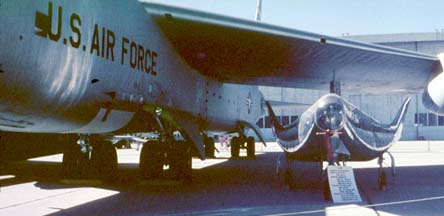 The Northrop HL-10, registered N804NA, was also
displayed by the NB-52B at the 1967 Edwards AFB Open House.
Colonel Cotton and Major Reschke launched it on its first glide
flight from the NB-52B on December 22 of 1966 with Bruce Peterson
at the controls. Its stability was so poor in its
original configuration that it did not fly again until March 15,
1968 after it had been modified to improve its flight
characteristics. Photo by Paul Minert via Greg Spahr.
The Northrop HL-10, registered N804NA, was also
displayed by the NB-52B at the 1967 Edwards AFB Open House.
Colonel Cotton and Major Reschke launched it on its first glide
flight from the NB-52B on December 22 of 1966 with Bruce Peterson
at the controls. Its stability was so poor in its
original configuration that it did not fly again until March 15,
1968 after it had been modified to improve its flight
characteristics. Photo by Paul Minert via Greg Spahr.
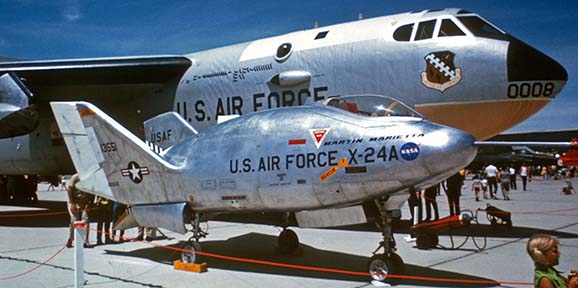 The Martin Marietta X-24A 66-13551, had made its thirteenth flight five days
earlier, when it was displayed with the NB-52B at the May 19,
1970 Edwards AFB Open house. John Manke was launched by Captain
Larson and Major Fornell from the NB-52B on the fourth powered
flight of the X-24A.
The Martin Marietta X-24A 66-13551, had made its thirteenth flight five days
earlier, when it was displayed with the NB-52B at the May 19,
1970 Edwards AFB Open house. John Manke was launched by Captain
Larson and Major Fornell from the NB-52B on the fourth powered
flight of the X-24A.
The first glide flight of the X-24A had occurred on April 17, 1969. It was piloted by Jerauld Gentry who was launched from the NB-52B by Lt Colonel Sturmthal and Captain Stroup. Lt Colonel Sturmthal and Captain Stroup then climbed into the NB-52A to launch John Manke in the HL-10 on its fifteenth flight on that same day.
The X-24A's engine was the same four-chambered XLR-11 design that had powered the X-1 on its first supersonic flight twenty three years earlier. The HL-10 and M2-F3 were also powered by the eight thousand pound thrust XLR-11 rocket engine.
The X-24A's last flight in its original configuration was its twenty-eighth flight on June 4, 1971. Manke was launched on that flight by Majors McDowell and Ranz.
The maximum speed attained during the X-24A program was mach 1.60 (1036 miles per hour) on the twenty-fifth flight on March 29, 1971 with John Manke at the controls. He had been launched from the NB-52B by Major Stroup and Captain Fritz.
The maximum altitude of the program was 71,400 feet, achieved during the nineteenth flight of the program, on October 27, 1970, also with John Manke as the pilot. The pilots of the NB-52B were Lt. Colonel Reschke and Squadron Leader Fisher.
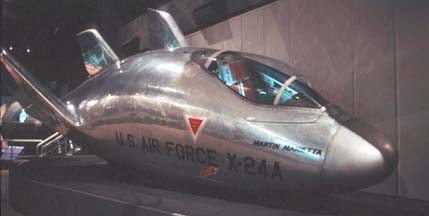 The Martin Marietta X-24A is
represented at the Air Force Museum by the originally jet powered
SV-5J, which has been reconfigured to resemble its rocket
propelled sibling. It is seen here on August 16, 1998.
Photographer: Brian Lockett.
The Martin Marietta X-24A is
represented at the Air Force Museum by the originally jet powered
SV-5J, which has been reconfigured to resemble its rocket
propelled sibling. It is seen here on August 16, 1998.
Photographer: Brian Lockett.
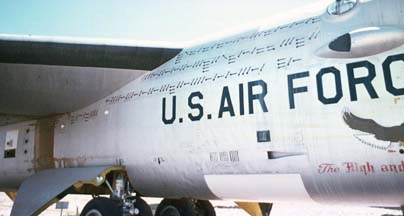 The NB-52A
in storage at MASDC on April 24, 1971. The NB-52A had been
retired to the Military Aircraft Storage and Disposition Center
(MASDC) at Davis Monthan AFB near Tucson, Arizona on October 19,
1969. The lox tank system was kept pressurized in the event that
it was needed to be returned to flight status to replace the
NB-52B. Photographer: Brian Lockett.
The NB-52A
in storage at MASDC on April 24, 1971. The NB-52A had been
retired to the Military Aircraft Storage and Disposition Center
(MASDC) at Davis Monthan AFB near Tucson, Arizona on October 19,
1969. The lox tank system was kept pressurized in the event that
it was needed to be returned to flight status to replace the
NB-52B. Photographer: Brian Lockett.
When the NB-52A was retired it had made just over 410 flights. It had launched the X-15 #1 thirty times, the X-15#2 eleven times, and the X-15#3 thirty-one times. It had launched the M2-F2 four times, the HL-10 eleven times and the X-24A twice.
All subsequent lifting body flights were launched from the NB-52B.
The X-15 mission history of the NB-52A in storage at MASDC on April 24, 1971. Horizontal profiles are captive flights, profiles angled upward are launches of the X-15.
The downward pointing X-15 in the center row corresponds to the second flight of the X-15 #3 on January 17, 1962. Majors Allavie and Bement launched Neil Armstrong (Link: NASA Dryden Biography) on an apparently uneventful flight to mach 5.51. The backward horizontal profile near the right side of the center row represents a return cross-country flight of the NB-52A with the X-15 #3 from Eglin AFB on May 5, 1962.
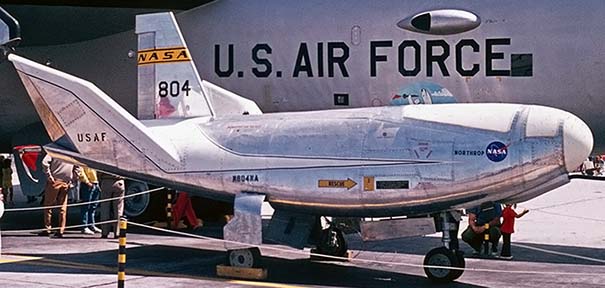 The Northrop HL-10 N804NA on display at the May 17,
1972 Edwards AFB Open House, which marked the twenty-fifth
anniversary of the Air Force. It had made the last of its
thirty-seven flights on July 17, 1970, with Major Peter Hoag at the controls.
He had been launched by Majors Fornell and Bowline. Photo by
Richard Lockett Sr.
The Northrop HL-10 N804NA on display at the May 17,
1972 Edwards AFB Open House, which marked the twenty-fifth
anniversary of the Air Force. It had made the last of its
thirty-seven flights on July 17, 1970, with Major Peter Hoag at the controls.
He had been launched by Majors Fornell and Bowline. Photo by
Richard Lockett Sr.
The maximum speed attained during the HL-10 program was mach 1.86 (1228 miles per hour) on the thirty-fourth flight on February 18, 1970 with Major Peter Hoag as the pilot. He had been launched from the NB-52B by Captain Fritz and Squadron Leader Fisher.
The maximum altitude of the program was 90,303 feet, achieved on February 27, 1970, during the thirty-fifth flight of the program, with Bill Dana as the pilot. The pilots of the NB-52B were Major Bowline and Captain Larson.
The HL-10 survives on a pylon in front of the NASA Dryden Flight Research Center at Edwards AFB.
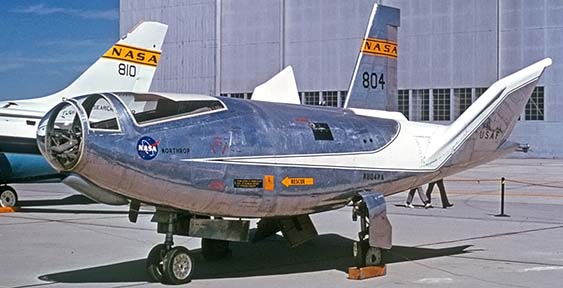 NASA Northrop HL-10 N804NA lifting body on
static display at the May 16, 1973 Edwards AFB Open House. Photographer: Richard Lockett
NASA Northrop HL-10 N804NA lifting body on
static display at the May 16, 1973 Edwards AFB Open House. Photographer: Richard Lockett
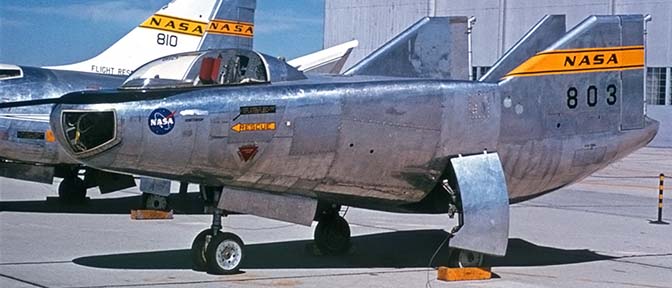 Northrop M2-F3 N803NA on
static display at the May 16, 1973 Edwards AFB Open House next to
the HL-10. Its sixteen glide
flights in its original M2-F2 configuration ran from July 12,
1966 to May 10, 1967. Following Bruce Peterson's accident on
the sixteenth flight, it was rebuilt with a third vertical
stabilizer. Its first flight as the M2-F3 took place on June 2,
1970 with Bill Dana flying the lifting body. He had been launched
from the NB-52B by Squadron Leader Fisher and Captain Fritz. The
M2-F3 made twenty-seven flights after modification. The last
flight was made on December 20, 1972 by John Manke, six months
before this picture was taken.
Northrop M2-F3 N803NA on
static display at the May 16, 1973 Edwards AFB Open House next to
the HL-10. Its sixteen glide
flights in its original M2-F2 configuration ran from July 12,
1966 to May 10, 1967. Following Bruce Peterson's accident on
the sixteenth flight, it was rebuilt with a third vertical
stabilizer. Its first flight as the M2-F3 took place on June 2,
1970 with Bill Dana flying the lifting body. He had been launched
from the NB-52B by Squadron Leader Fisher and Captain Fritz. The
M2-F3 made twenty-seven flights after modification. The last
flight was made on December 20, 1972 by John Manke, six months
before this picture was taken.
The maximum speed attained during the M2-F3 program was mach 1.61 (1064 miles per hour) on the twenty-sixth flight on December 13, 1972 with Bill Dana as the pilot. He had been launched from the NB-52B by Majors Luck and Fiedler.
The maximum altitude of the program was 71,500 feet, achieved on the last flight on December 20, 1972, with John Manke as the pilot. The pilots of the NB-52B were again Majors Luck and Fiedler.
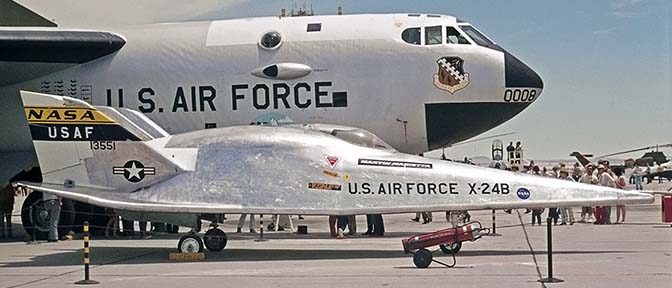 NASA Martin-Marietta X-24B 61-13551 lifting body displayed next to the Boeing NB-52B Stratofortress 52-0008. Martin Marrieta created an entirely new aerodynamic shape for the X-24B by building an aluminum glove over the existing X-24A airframe. It is seen here at the May 16, 1973 Edwards AFB Open House. Its first glide flight was the following August 1, piloted by John Manke. The pilots of the NB-52B were Lt. Colonel Ranz and Captain Higgins. Photographer: Richard Lockett
NASA Martin-Marietta X-24B 61-13551 lifting body displayed next to the Boeing NB-52B Stratofortress 52-0008. Martin Marrieta created an entirely new aerodynamic shape for the X-24B by building an aluminum glove over the existing X-24A airframe. It is seen here at the May 16, 1973 Edwards AFB Open House. Its first glide flight was the following August 1, piloted by John Manke. The pilots of the NB-52B were Lt. Colonel Ranz and Captain Higgins. Photographer: Richard Lockett
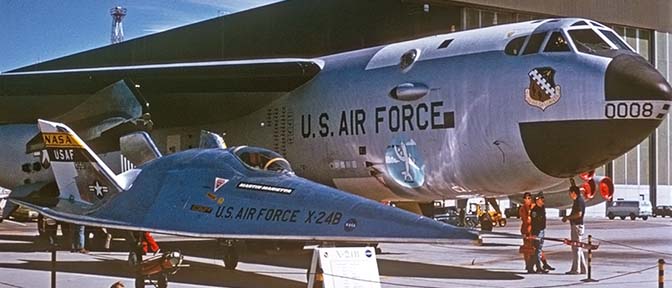 NASA Martin-Marietta X-24B 61-13551 lifting body displayed next to the Boeing NB-52B Stratofortress 52-0008. Photographer: Richard Lockett
NASA Martin-Marietta X-24B 61-13551 lifting body displayed next to the Boeing NB-52B Stratofortress 52-0008. Photographer: Richard Lockett
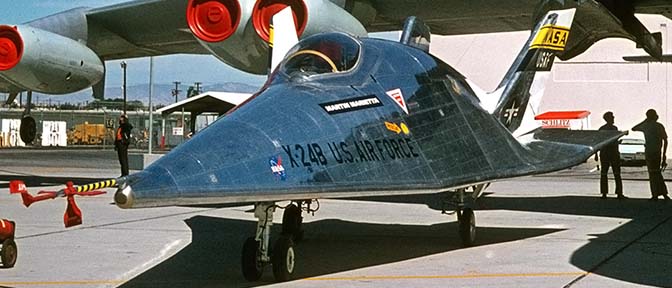 NASA Martin-Marietta X-24B 61-13551 lifting body displayed next to the Boeing NB-52B Stratofortress 52-0008. Photographer: Richard Lockett
NASA Martin-Marietta X-24B 61-13551 lifting body displayed next to the Boeing NB-52B Stratofortress 52-0008. Photographer: Richard Lockett
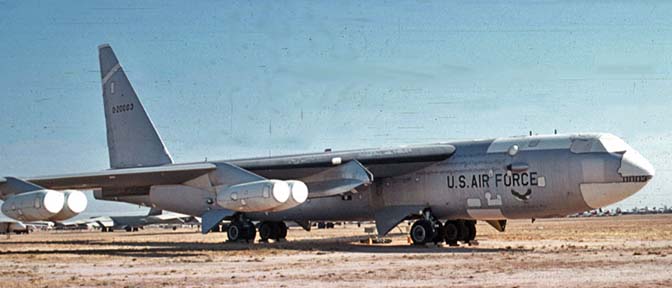 Back at MASDC, the NB-52A sat unused on November 12,
1973. Photographer: Brian Lockett.
Back at MASDC, the NB-52A sat unused on November 12,
1973. Photographer: Brian Lockett.
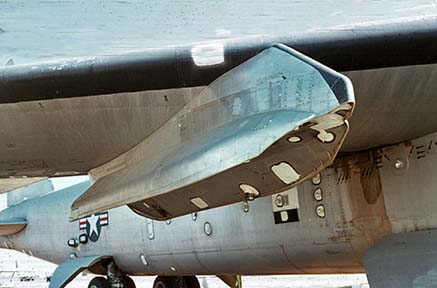 Close-up of the X-15 pylon on the NB-52A in MASDC on
November 12, 1973. Photographer: Brian Lockett.
Close-up of the X-15 pylon on the NB-52A in MASDC on
November 12, 1973. Photographer: Brian Lockett.
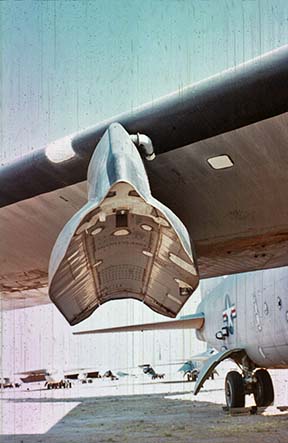 Close-up of the X-15 pylon on the NB-52A in MASDC
on November 12, 1973. Photographer: Brian Lockett.
Close-up of the X-15 pylon on the NB-52A in MASDC
on November 12, 1973. Photographer: Brian Lockett.
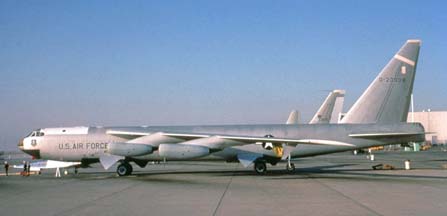 The NB-52B
appeared at the December 1, 1974 Edwards AFB Open House in the
company of the X-24B. The rear fuselage of the X-24B had been
painted white. The next X-24B flight was on December 17. Lt.
Colonel Michael Love piloted the X-24B to mach 1.585 (1005 miles
per hour) and and altitude of 68780 feet on its eighteenth flight
in its new configuration. Note the tail of KC-135A, serial
55-3135 just beyond the NB-52B. That stratotanker is still seen
performing tanker demonstrations at the open house. Photo by T.
Waddington via Paul Minert and Greg Spahr.
The NB-52B
appeared at the December 1, 1974 Edwards AFB Open House in the
company of the X-24B. The rear fuselage of the X-24B had been
painted white. The next X-24B flight was on December 17. Lt.
Colonel Michael Love piloted the X-24B to mach 1.585 (1005 miles
per hour) and and altitude of 68780 feet on its eighteenth flight
in its new configuration. Note the tail of KC-135A, serial
55-3135 just beyond the NB-52B. That stratotanker is still seen
performing tanker demonstrations at the open house. Photo by T.
Waddington via Paul Minert and Greg Spahr.
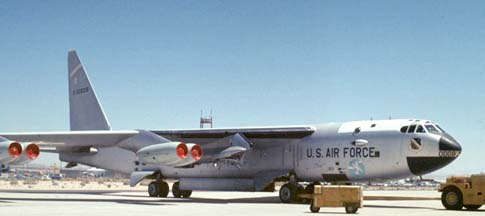 The NB-52B
on the ramp at Edwards AFB on July 6, 1975. The mount adapter for
the X-24B is attached to the X-15 pylon. Photographer: Brian
Lockett.
The NB-52B
on the ramp at Edwards AFB on July 6, 1975. The mount adapter for
the X-24B is attached to the X-15 pylon. Photographer: Brian
Lockett.
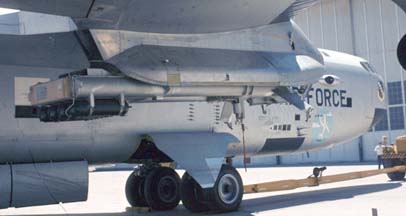 Detail shot of the X-24B mount adapter on the NB-52B
at Edwards AFB on July 6, 1975. Photographer: Brian Lockett.
Detail shot of the X-24B mount adapter on the NB-52B
at Edwards AFB on July 6, 1975. Photographer: Brian Lockett.
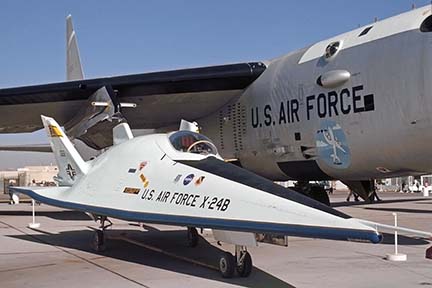 Martin Marietta X-24B 65-13551 with Boeing NB-52B 52-0008 at Edwards AFB Open House, November 16, 1975
Martin Marietta X-24B 65-13551 with Boeing NB-52B 52-0008 at Edwards AFB Open House, November 16, 1975
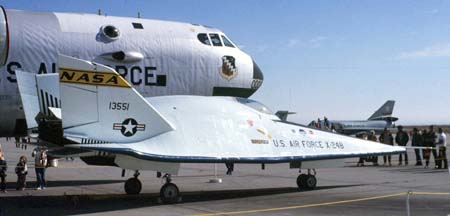 After the November 16, 1975 Edwards
AFB Open House, the X-24B
would make two more flights on November 19 and 26. They would
mark the last flights of the four-chambered XLR-11 rocket engine
that had first powered the X-1 in 1947. The last flight was
piloted by Captain Francis Scobee. Photographer: Brian Lockett.
After the November 16, 1975 Edwards
AFB Open House, the X-24B
would make two more flights on November 19 and 26. They would
mark the last flights of the four-chambered XLR-11 rocket engine
that had first powered the X-1 in 1947. The last flight was
piloted by Captain Francis Scobee. Photographer: Brian Lockett.
The maximum speed attained during the thirty-six flights of the X-24B program was mach 1.76 (1163 miles per hour) on the sixteenth flight on October 26, 1974 with Mike Love as the pilot.
The maximum altitude of the program was 74,130 feet, achieved on the twenty-third flight on May 22, 1975, with John Manke as the pilot.
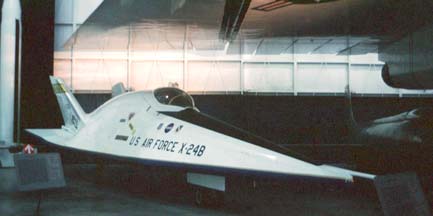 The Martin Marietta
X-24B is displayed under the wing of the North American
XB-70A Valkyrie at the Air Force Museum. It is seen here on
August 16, 1998. Photographer: Brian Lockett.
The Martin Marietta
X-24B is displayed under the wing of the North American
XB-70A Valkyrie at the Air Force Museum. It is seen here on
August 16, 1998. Photographer: Brian Lockett.
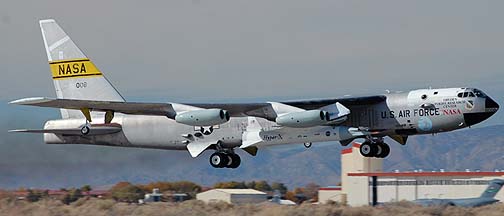 Boeing NB-52B
Stratofortress Mothership.
Boeing NB-52B
Stratofortress Mothership.
eBook edition of Balls Eight: History of the Boeing NB-52B Stratofortress Mothership |
||
|
My book Balls Eight: History of the Boeing NB-52B Stratofortress Mothership is now available as an eBook for just $10.99, a considerably reduced price compared to the print edition. It has been asserted that the Boeing NB-52B Stratofortress, carrying Air Force serial 52-0008, can lay claim to being the airplane that has seen and participated in more history than any other single airplane. For forty-five years, the NB-52B was a fixture at Edwards Air Force Base. While the NB-52B is most famous for launching the three North American X-15 rocket planes, it continued to serve in the role of launch platform for a multitude of programs until its final mission, launching the Mach-10 X-43A Hyper-X, on November 16, 2004. It was the oldest flying B-52 by nearly ten years. The eBook edition is profusely illustrated with vintage photographs and diagrams and has more pictures than the print edition. It can be dowloaded directly from Lulu.com. It will soon be available from Apple iBookstore, Amazon, Barnes & Noble, and Kobo. | ||
|
Balls Eight: History of the Boeing NB-52B Stratofortress Mothership |
||
It has been asserted that the Boeing NB-52B Stratofortress, carrying Air Force serial 52-0008, can lay claim to being the airplane that has seen and participated in more history than any other single airplane. For forty-five years, the NB-52B was a fixture at Edwards Air Force Base. While the NB-52B is most famous for launching the three North American X-15 rocket planes, it continued to serve in the role of launch platform for a multitude of programs until its final mission on November 16, 2004. It was the oldest flying B-52 by nearly ten years.The NB-52B launched the three X-15 hypersonic rocket planes.
It launched the Northrop HL-10, Northrop M2-F2/F3, Martin Marietta X-24A and Martin Marietta X-24B lifting bodies.
It simulated the steep, power off approach to landing used by the Space Shuttles.
It assisted in the collection of data about wake turbulence from large aircraft.
It served as an air-to-air gunnery target.
It launched 3/8-scale F-15 Remotely Piloted Research Vehicles (RPRV) and Spin Research Vehicles (SRV).
It launched a Ryan Firebee II drone and the Ryan Firebee based Drones for Aeroelastic Structures Testing (DAST).
It launched the Highly Maneuverable Aircraft Technology (HiMAT) RPRVs.
It dropped the 48,000-pound Space Shuttle Reusable Booster Drop Test Vehicle (SRB/DTV).
It released a simulated F-111 crew module from its bomb bay to evaluate new parachute recovery systems.
It was the first airplane to launch a satellite into orbit on the Orbital Sciences Pegasus booster.
It tested the drag chute used to decelerate space shuttle orbiters.
It tested pollution reducing fuel additives with a pair of jet engines mounted under its bomb bay.
It launched the X-38 Space Station Crew Return Vehicles.
It launched the X-43A Hyper-X Supersonic Combustion Ramjets.
The book is 200 pages long. It contains 246 color photographs, 89 black and white photographs, and 2 other illustrations.
You can preview the first several pages of the book.
Books are printed on demand by Lulu.com. When you order one, it is placed in your Lulu.com shopping cart. Lulu.com prints, packages, and ships the book direct to you.

Put a copy of the softcover edition of Balls Eight: History of the Boeing NB-52B Stratofortress Mothership in your Lulu.com shopping cart for $74.95.

Put a copy of the hardcover edition of Balls Eight: History of the Boeing NB-52B Stratofortress Mothership in your Lulu.com shopping cart for $79.95.
Revell has re-released Monogram's 1/72-scale Boeing NB-52B Stratofortress with X-15A-2 kit. You need this book to help you establish the appropriate paint scheme for any particular NB-52B mission that you want to model.
The book is 96 pages long.
You can preview the first several pages of the book.
Books are printed on demand by Lulu.com. When you order one, it is placed in your Lulu.com shopping cart. Lulu.com prints, packages, and ships the book direct to you.
 Put a copy of the softcover edition of Painting Guide for the Boeing Stratofortress Motherships in your Lulu.com shopping cart for $44.95.
Put a copy of the softcover edition of Painting Guide for the Boeing Stratofortress Motherships in your Lulu.com shopping cart for $44.95.
You can buy a 2020 calendar featuring photographs of the Boeing NB-52B Stratofortress Mothership that launched the X-15s in the 1960s and continued launching research vehicles until 2004.
It has been asserted that the Boeing NB-52B Stratofortress, carrying Air Force serial 52-0008, can lay claim to being the airplane that has seen and participated in more history than any other single airplane. This calendar features a dozen pictures of the NB-52B carrying some of the research vehicles that it launched over the years. Photo sources: Air Force, NASA, Richard Lockett, Brian Lockett:
North American X-15-1, 1960
North American X-15-3, 1963
North American X-15A-2, 1967
Northrop HL-10, 1969
Martin-Mariettta X-24A, 1970
Northrop M2-F3, 1972
Martin-Mariettta X-24B, 1973
Orbital Sciences Pegasus, 1989
Supersonic Supercruise, 1995
X-38 V-131R, 2000
X-43A Hyper-X, 2004
 Put a copy of the Balls Eight: Boeing NB-52B Stratofortress Mothership: 2020 calendar in your Lulu.com shopping cart for $14.95.
Put a copy of the Balls Eight: Boeing NB-52B Stratofortress Mothership: 2020 calendar in your Lulu.com shopping cart for $14.95.
- advertisement -
 Books about
Lifting Bodies, Edwards Air Force Base, and the X-15 available
from
Books about
Lifting Bodies, Edwards Air Force Base, and the X-15 available
from 
 Flying Without Wings : Nasa Lifting
Bodies and the Birth of the Space Shuttle by Milton O. Thompson
Flying Without Wings : Nasa Lifting
Bodies and the Birth of the Space Shuttle by Milton O. Thompson
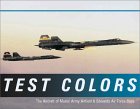 Test Colors: The Aircraft of Muroc Army Airfield
and Edwards Air Force Base by Rene Francillon
Test Colors: The Aircraft of Muroc Army Airfield
and Edwards Air Force Base by Rene Francillon
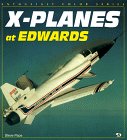 X-Planes at Edwards (Enthusiast Color
Series) by
Steve Pace
X-Planes at Edwards (Enthusiast Color
Series) by
Steve Pace
 Edwards Air Force Base : Open House at the USAF
Flight Test Center 1957-1966 : A Photo Chronicle of
Aircraft Displayed (Schiffer Military History) by Robert D. Archer
Edwards Air Force Base : Open House at the USAF
Flight Test Center 1957-1966 : A Photo Chronicle of
Aircraft Displayed (Schiffer Military History) by Robert D. Archer
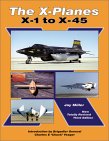 The X-Planes: X-1 to X-45: 3rd Edition
by Jay Miller
The X-Planes: X-1 to X-45: 3rd Edition
by Jay Miller
 Angle of Attack : Harrison Storms and the Race to
the Moon by Mike Gray. The biography of Harrison Storms, who
was instrumental in the development and operation of the X-15.
Angle of Attack : Harrison Storms and the Race to
the Moon by Mike Gray. The biography of Harrison Storms, who
was instrumental in the development and operation of the X-15.
 At the Edge of Space : The X-15 Flight Program
by Milton O. Thompson. The story of test flying the X-15 from the
point of view of the pilot.
At the Edge of Space : The X-15 Flight Program
by Milton O. Thompson. The story of test flying the X-15 from the
point of view of the pilot.
Send a message to Brian.
Go to home page of the Goleta Air and Space Museum.